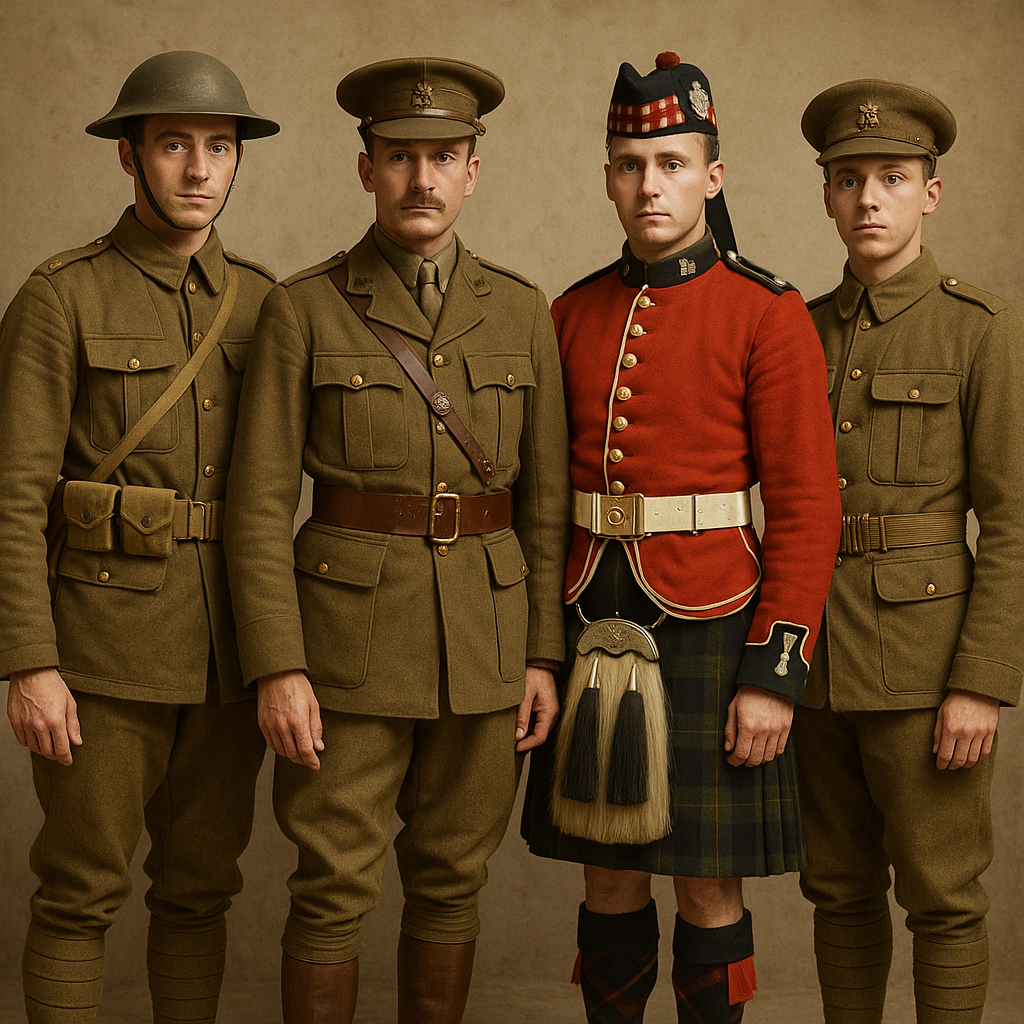
Inside WWI British Uniforms: What Soldiers Wore in the Great War
Published on Jun 01, 2025
WWI British Uniforms: A Glimpse into the Fabric of History
The First World War marked a transformative period in military history—not only in strategy and weaponry but also in the uniforms worn on the battlefield. British soldiers went from ceremonial attire to rugged, purpose-built clothing designed for trench warfare. These WWI British uniforms weren’t just fabric and thread—they were symbols of duty, rank, and regional pride.
This article explores the full scope of WWI British uniforms, including distinctions among officers, guardsmen, and Scottish units, highlighting their design, evolution, and enduring significance.
The Standard British Soldier’s Uniform: Utility Over Tradition
By the start of World War I in 1914, the British Army had already made strides toward practicality. The iconic red tunics of the 19th century were replaced by a more subdued, khaki-coloured outfit: the 1902 Pattern Service Dress.
Key Components of the WWI Soldier’s Uniform:
- Khaki Tunic: Made of thick wool, this four-pocket jacket was designed for functionality, warmth, and storage during long stretches in the trenches.
- Wool Trousers: Matched with the tunic, they were designed for warmth and durability.
- Puttees: Longwool strips wrapped around the shins to prevent dirt and water from entering boots.
- Boots: Ankle-length ammunition boots with hobnailed soles.
- Webbing Equipment: The 1908 Pattern Webbing system held ammunition, water, and other essentials, freeing soldiers’ hands for combat.
- Headgear: Soldiers initially wore cloth caps, but the iconic Brodie steel helmet was introduced in 1915 to protect against shrapnel and debris.
WW1 British Officer Uniforms: Authority and Elegance
Officers in the British Army had distinct uniforms that subtly separated them from enlisted men, both in form and fabric. Unlike regular soldiers, officers purchased their uniforms, allowing for variations in quality and customization.
Features of the British Officer Uniform:
- Tailored Tunic: Officers’ tunics were finely cut, featuring open collars with shirt and tie combinations instead of the buttoned-up style worn by enlisted men.
- Sam Browne Belt: A wide leather belt with a shoulder strap used for holstering pistols and sabres.
- Breeches & Boots: Officers often wore riding breeches with knee-high leather boots, ideal for mobility and mounted operations.
- Peaked Cap: Unlike the round caps worn by soldiers, officers wore a peaked service cap, often with regiment-specific insignia.
- Rank Insignia: Displayed on shoulder epaulettes or cuffs, depending on the year and regiment.
Despite the harsh battlefield conditions, officer uniforms retained a sense of formality, signifying leadership and discipline.
British Guardsman Uniforms: Ceremonial Pride Meets Combat Utility
The Guards regiments, such as the Grenadier and Coldstream Guards, are known for their ceremonial dress—but they also served valiantly on the front lines of WWI.
Differences in Guardsman Uniforms:
- Full Dress (Ceremonial): Includes the famous red tunic and bearskin hat, typically worn during peacetime or ceremonial occasions.
- Field Service Dress: During the war, guardsmen wore standard khaki service dress but retained subtle regimental details such as unique collar badges or brass buttons bearing their insignia.
Guards units carried centuries-old traditions into modern warfare, blending elegance with effectiveness.
Scottish Uniforms: Tartan, Tradition, and Tenacity
Scottish regiments brought a fierce and unmistakable identity to the British Army during WWI. While many adopted the standard service dress for practicality, certain traditional elements remained.
Characteristics of Scottish Military Dress:
- Kilts: Highland regiments were known for wearing kilts, even in battle, crafted from their unique clan tartans. Kilts were often worn with khaki aprons to protect the fabric.
- Trews: Some Lowland regiments opted for trews (tartan trousers), especially in colder or muddier conditions.
- Doublets: These traditional Scottish jackets were occasionally worn over kilts, adorned with decorative buttons and braiding.
- Headgear: Regiments wore Glengarry or Balmoral bonnets, often adorned with toories (pom-poms) and badge pins reflecting regimental identity.
The Scottish contribution to WWI remains one of bravery, cultural pride, and distinct martial fashion.
Evolution of British Military Uniforms During WWI
Wartime conditions forced rapid evolution in uniform design. As trench warfare exposed soldiers to extreme weather, chemical weapons, and relentless artillery, the British Army adapted accordingly.
Major Adaptations:
- Introduction of the Steel Helmet: The Brodie helmet significantly reduced head injuries from shrapnel and debris.
- Gas Protection Gear: Early gas masks were issued to protect against chlorine and mustard gas attacks.
- Simplified Manufacturing: To support mass production, uniforms became more standardized, minimizing decorative elements without sacrificing functionality.
- Colour Consistency: Early shortages forced the temporary use of “Kitchener Blue” uniforms until khaki wool became widely available again.
These adaptations reflected the brutal realities of WWI, making survival—not appearance—the top priority.
The Enduring Legacy of WWI British Uniforms
The impact of WWI British uniforms reaches far beyond the battlefields of France and Belgium. Their design principles—durability, functionality, and identity—continue to influence modern military attire.
Why They Still Matter:
- Military Reenactments & Museums: Enthusiasts and historians preserve the look and feel of WWI uniforms through living history displays and exhibitions.
- Film & Media: Authentic WWI British uniforms are a staple in historical documentaries and war dramas, keeping the memory of The Great War alive.
- Cultural Heritage: Uniforms from regiments like the Scots Guards or Highlanders remain symbols of national pride and heritage.
Conclusion
WWI British uniforms were far more than battlefield attire—they were the visual representation of a nation’s resilience and adaptability. From the practical wool tunics of infantrymen to the proud tartans of Scottish regiments and the formal elegance of officers, each uniform told a story of service, sacrifice, and tradition.
As time moves forward, these uniforms remain a poignant reminder of a transformative era in military history. Whether studied, reenacted, or collected, they continue to teach us about the values and endurance of those who wore them in the most trying of circumstances.
